2013 was cleantech’s year for major accomplishments.
Explosive growth was viewed in solar, both in terms of installations and the financing mechanisms used to fund them. Cleanweb applications matured, and the integration of clean energy technologies with traditional fuels, especially natural gas production, went from a pie-in-the-sky idea to a genuine business model with real investors, and real profits.
It was also a year with lots of silliness. One inventor created a “breathing” bicycle to protect people from pollution; another invented a smog-eating sidewalk. Scientists figured out ways to turn toxic pooh and virulent diseases into energy sources. We received green jetliners, printers that use pencils and food, and lights powered by human blood.
Many cleantech inventions of 2013 were just plain goofy. Many also carried the subtext, either implied or overt, of fear.
Seemingly every week, our environment shows new signs of growing ever more extreme. A bicycle that purifies the polluted air of Beijing may be the perfect example of how humans attempt to adapt to such rapid changes: they invent things that are themselves extreme, and often just a bit goofy-looking (exhibit A: Henry Ford’s first Quadricycle, which steered with a gangly tiller thingy).
Here we present the best of the oddest, the wackiest cleantech inventions of 2013.
1) The Lamp of Human Blood
Many have remarked on this disturbing contraption. However, it makes some sense, in a creepy kind of way. What if power literally cost us a drop of blood? Designer Mike Thompson claims to have invented a lamp that runs on human blood, although from his painful-looking, choppily-edited video, we have our doubts about whether blood is actually powering the thing. Does the chemistry work? The answer is uncertain. Will investors and consumers flock to this “cleantech”? Most assuredly, they will not. Regardless, its very weirdness makes a point.
The blood lamp won a lot of headlines back when it was introduced in 2009. The idea never turned into a commercial product, leaving all our tasty blood on the table for vampires. But the idea of suffering for light–even just a little–never went away. By 2013 the concept evolved into GravityLight, an LED lamp powered by gravity’s pull on a sack filled with stuff (rocks, sand, anything handy and heavy). Each lamp costs just $10 which makes it ideal for sales in developing countries. It went into production in December.
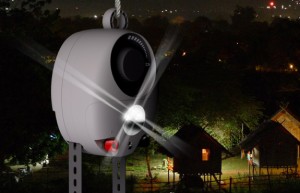
2) Billboard as Water Fountain
Lima, Peru is a giant city built in a desert. But there’s plenty of moisture in the air. Researchers from the University of Engineering and Technology of Peru have created a billboard that uses reverse osmosis to capture that moisture and turn it into potable water. Sure, it’s more of a publicity stunt than a cost-effective way to deal with water shortages around the globe, but the nice children in this video seem to appreciate it anyway.
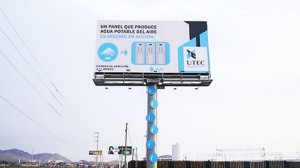
3) Generating Power from Pooh
We’re good at turning waste into energy—just look at power plants that burn garbage and Toyotas that charge their batteries from brake heat. Now this trend seems to have reached an extreme. Scientists at Nanyang Technological University in Singapore say they have found a new way to turn human pooh into biogas, which can be used directly for cooking or converted into electricity. Meanwhile researchers in the U.K. and South Korea say they’ve figured out ways to turn the deadly virus E. coli into diesel and gasoline. The technology “still faces many significant commercialization challenges,” says Science Daily. Read: If you really want gasoline, it may be cheaper to kill a dinosaur yourself.
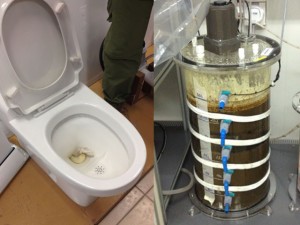
4) Sidewalks, Bicycles Combat Smog
In Beijing, if you’re riding a normal bicycle or walking a normal sidewalk, you’re inhaling poisonous smog. Lucky for us, not-so-normal variants exist. A new form of pavement tested out along a city block in Hengelo, Netherlands can reduce nitrogen oxide air pollution by up to 45 percent through the use of titanium oxide, which neutralizes the pollutants. And artist Matt Hope has created a bicycle that uses pedal power to purify polluted air. The contraption includes bonus points for cool: riders get to wear a moped helmet connected to a fighter pilot’s breathing mask; that, combined with the jet engine-looking filtration system, makes the inordinately slow mountain bike appear to be ready to take flight. Just don’t move your head too much!
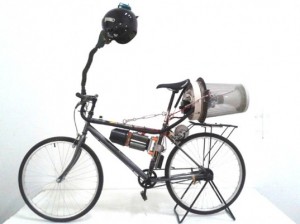
5) The Robot that Eats Buildings
A major driver of exurban development is the high cost of demolishing buildings in urban cores. Recycling the concrete is possible, but the process adds additional costs and exposes workers to dangerous chemicals. So designer Omer Haciomeroglu developed ERO, a robot that recycles buildings by separating concrete from steel rebar. Both materials can then be reused to build new buildings.

6) The Green Airliner
Human flight is a miracle of the modern age, but it’s also the least-efficient mode of travel. Now Honeywell and the French rocket company Safran have teamed up to reduce the environmental impact of flying—just a little. They’ve created a green taxiing system for airliners that allows jets to back away from airport gates and motor toward the runway using electric motors, rather than firing up noisy, air-polluting engines. The system will reduce an airline’s fuel consumption by up to 4 percent, and shave a minute and a half off the time it takes to start the engines and begin taxiing.
Who needs jet fuel anyway? In July the Solar Impulse aircraft completed the first solar-powered flight across the U.S. and is planning for its around the world journey in 2015.
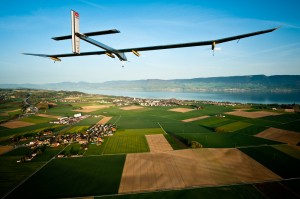
7) Turn your Chevy Chevette into Clean Energy
An international team of researchers proved it’s possible for rust to split water into hydrogen and oxygen using sunlight, and storing about 15 percent of the captured solar energy as hydrogen. The development could be good for news for cleantech applications because rust is cheap, as any proud owner of a 1986 Chevy Chevette already knows.
